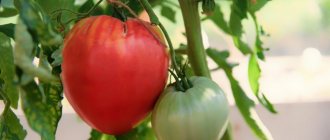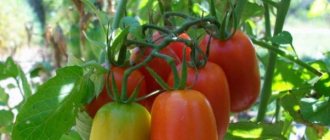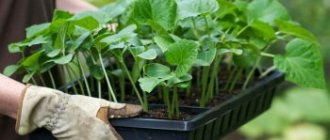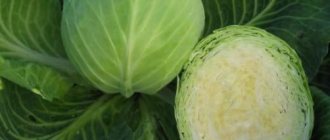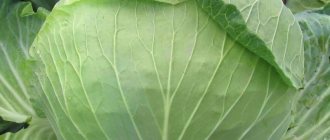Vegetable growing » Cabbage
0
1252
Article rating
Kira Stoletova
The Krautman cabbage variety is loved by gardeners due to its many advantages. The culture is characterized by high yield, excellent taste and presentable appearance.
Characteristics of Krautman cabbage
Characteristics of Krautman cabbage
Krautman cabbage (pictured below) is a mid-season white cabbage variety. The period from germination to harvest lasts 4-6 months. The rosette of the plant is compact in size. Consists of slightly wrinkled, raised smooth leaves of medium size. The edges are even, smooth, the color is rich emerald, with a waxy coating of medium to strong intensity. The inner leaves are thin, delicate, light in color (lighter than the outer ones). The inner stalk is the same length as the outer one. The average weight of heads of cabbage is about 1.8-4.5 kg. Some specimens grow up to 6-7 kg.
The head of Krautman cabbage is half-covered, medium in size, round in shape, dense in structure
The heads of cabbage have an attractive appearance, do not crack in any weather conditions, and do not rot. They are stored for a long time after ripening on the root and are perfectly transported over long distances without loss of taste. The hybrid also adapts well to any weather conditions.
Harvesting and storage
To harvest vegetables, you should choose a dry day and cut the stalk only with a sharply sharpened blade. If you plan to store the cabbage hanging, the stalk is not cut short. The top 2-3 sheets are also left for storage.
Heads of cabbage stored for storage must be intact, without cracks or damage by pests. Cabbage can be placed in sand or a box (in 1 layer), or wrapped in paper and placed on shelves or hung by a long stalk from a ceiling beam.
Important! As experienced gardeners have noticed, after the first frost the heads of cabbage become juicier and softer. Long-term storage conditions include 85–95% humidity and temperatures around 0°C
The room should be ventilated once a month. Krautman cabbage has proven itself to be a reliable hybrid with attractive and tasty heads. By providing the vegetable with proper care and protection from diseases, you can get a rich harvest.
Long-term storage conditions include 85–95% humidity and temperatures around 0°C. The room should be ventilated once a month. Krautman cabbage has proven itself to be a reliable hybrid with attractive and tasty heads. By providing the vegetable with proper care and protection from diseases, you can get a rich harvest.
Advantages and disadvantages
Advantages of the Krautman hybrid:
- high productivity;
- friendly return of the harvest;
- the heads of cabbage do not rot or crack;
- excellent presentation;
- heads of cabbage can remain in the beds for a long time after full ripening;
- good transportability over long distances;
- excellent keeping quality;
- immunity to fungal diseases;
- easily adapts to a variety of weather conditions.
Disadvantages of the variety:
- weak root system, which leads to the plant falling on its side, under the weight of ripening heads of cabbage;
- lack of resistance to clubroot.
Reviews about Krautman
This hybrid of Dutch selection appeared in the Russian Federation not long ago. But during this time, many farm owners and amateur summer residents have already fallen in love with it. Therefore, reviews of the Krautman hybrid can only be found laudatory.
Antonina Arkadievna, Tobolsk
I have been growing Krautman for several years in a row. I don’t know of a more problem-free cabbage. Grows well. The heads of cabbage are pouring to perfection. All are plump and even. It’s nice to look at them both in the garden and in the basement. Cabbage stores wonderfully. I'm cleaning it up in October. I make a little sauerkraut every month. Very tasty in fresh salads. All in all. I have already recommended Krautman to all my friends, and I know that they are only thanking me for the advice.
Heinrich, Tolyatti
Krautman is a great variety. Consider it growing on its own. Does not crack from rain or drought. If the weather is bad, small heads of cabbage may appear. But if you consider that I grow only for my family, and give a little to my children, then the size of the heads of cabbage doesn’t really bother me. The main thing is that it grows and forms dense forks, and the rest is nonsense. But you don’t have to poison cabbage every 2 weeks from various misfortunes.
Angelina Pavlovna, Cherkassy
Not bad Krautman cabbage. But I like Aggressor better. It lasts longer, and they grow almost the same. But in second place for me personally is Krautman.
Planting and caring for Krautman cabbage
To plant Krautman cabbage, you need to choose areas with loose, fertile loamy soil. They should also be well lit. The hybrid can be grown in seedlings and by direct sowing in the ground. The planting method depends on the weather conditions of the region where the vegetable plant is cultivated.
Planting seeds directly into open ground can be done in warm climate regions. In this case, it is necessary to wait for the soil to completely warm up to 14-15 ° C. At the same time, at night the air temperature should not drop below 16-18 °C.
In regions with cold climates, it is recommended to grow Krautman cabbage using seedlings. At the same time, pre-grown and strengthened seedlings are planted in closed or open ground. Approximately, the seedling is ready for transplantation at the age of 35-45 days.
It is recommended to sow seeds in early April. You can use wooden boxes for planting, which must be filled with soil. The seeds are sown in specially prepared grooves, to a depth of 1 cm. The recommended distance between seeds is at least 3 cm. The grooves are covered with earth on top, compacted and watered. The crops are covered with film and placed in a warm, bright place. After the shoots emerge, the film is removed. In the phase of 2 true leaves, you can pick. Before planting in open ground, seedlings must be hardened off.
Advice! The air temperature in the room where seedlings are grown should be at least 12-15 °C.
It is recommended to plant seedlings at the end of May. The layout of the seedlings is 50 x 50 cm.
Step-by-step planting of Krautman cabbage seedlings:
- Water is poured into the previously prepared wells.
- The roots are placed in them.
- Sprinkle with soil up to the first pair of leaves.
- Compact the soil around the seedling.
- Water a little on top.
In the first few days, it is recommended to shade the seedlings, thereby protecting them from direct sunlight, which negatively affects survival rate.
It is necessary to care for the Krautman hybrid traditionally, just like other varieties of cabbage. Recommended care procedures include:
- watering;
- loosening;
- hilling;
- fertilizing
It is recommended to carry out the first watering with a solution of potassium permanganate (light pink). In the future, the cabbage is watered once a week. Water consumption – 12 l per 1 m2. Watering is especially important for plants in the first period after planting, during the active growth of green mass and the rapid setting of heads of cabbage.
The first feeding should be carried out 21 days after transplanting the seedlings. Mullein solution can be used as a fertilizer. It is recommended to repeat the procedure after 14 days.
It is necessary to feed cabbage at the second stage of the growing season, adhering to the following rules:
- The amount of potassium and phosphorus fertilizers applied to the soil is doubled.
- Fertilizing with nitrogen is carried out twice as often.
Important maintenance activities are weeding, loosening and hilling. These procedures contribute to the formation of a powerful root system and increased productivity.
History of variety development
The seed company Bejo Zaden, located in the Netherlands, sells vegetable seeds, as well as develops new varieties and hybrids of various vegetables. This company is known to farmers all over the world and has its representative offices almost everywhere. According to employees of this company, they are not known only in Antarctica.
The variety was bred by Dutch breeders in the last quarter of the last century, and was included in the State Register of Russia in 1993. This hybrid is zoned and intended for cultivation in almost all regions of the country. It is grown by farmers in Ukraine and Moldova.
Diseases and pests
The Krautman variety is highly resistant to fungal diseases. The plant has weak immunity to diseases such as:
- Blackleg. The spread of the disease can be prevented by pulling out infected seedlings and removing them. The soil is treated with a solution of Bordeaux mixture (1%) and copper sulfate (5 g per 10 l of water).
Appears as black areas on plants; over time they die
- Kila. Characteristic signs are yellowing and wilting of plants. Affected foliage must be removed and the soil sprinkled with lime.
To prevent clubroot, seedlings can be treated with wood ash.
Pests that threaten Krautman cabbage include:
- cabbage fly;
- cruciferous flea beetle;
- cabbage whites.
Features of agricultural technology
Sowing seeds: timing and rules
Seeds are planted in soil poured into wooden boxes or other containers in early April. Grooves are made in the soil. The seeds are buried in them by 10 mm, the distance is maintained at about 30 mm.
The planted material is sprinkled with earth, watered and compacted (lightly). Cover the box with plastic wrap.
On the 6th (sometimes 5) day the first shoots will appear. Picking is done after the formation of two leaves. Then the seedlings are placed in pots.
A few weeks before the planned transplantation of cabbage into open ground, the plants are hardened off. The pots are taken outside for a while each day to acclimate to the wind and natural light.
Planting seedlings in the ground
It is recommended to transplant seedlings into open soil in late May. Planting pattern - 50x50 cm. It is optimal to grow Krautman on fertile loamy lands that previously contained legumes or pumpkin crops.
Small holes are prepared in the ground and filled with water. The roots of the seedlings are lowered into the soil, sprinkled, the earth is compacted and watered. For the first 3–5 days, it is advisable to shade the seedlings so that the sun's rays cannot negatively affect fragile plants.
Caring for Krautman cabbage
The hybrid loves moisture. Therefore, it should be watered regularly. For the first time, the soil is irrigated with water with potassium permanganate added to it (you should get a weak solution with a slightly pink tint).
Subsequently, watering is carried out in the evening or in the morning with settled warm liquid every few days. For 1 square of crops, 12 liters of water are needed. Watering is made more intense when tying cabbage heads.
The hybrid needs fertilizing, which significantly increases productivity. The first is performed 15–20 days after transplanting the seedlings. The second one is made after another 3 weeks.
For the first feeding, use an infusion of mullein (for 1 part take 8 parts of water) or bird droppings (1 to 12). Each seedling requires about 500 mg of the prepared solution.
Similar infusions are used for the second feeding. But in this case, you need to fertilize the cabbage with a large amount of the mixture (1 l).
High-quality plant care involves spraying its leaves with a special mixture (the procedure is called foliar feeding). For 10 liters of water take:
- superphosphate – 4 g;
- urea – 60 g;
- vitamin C – 1 g.
The leaves are treated with this solution every three weeks. Starting from the third feeding, 20–30% less urea is added to the water.
Full development and growth of seedlings is impossible without periodic loosening of the soil. This simple operation provides the cabbage roots with moisture and oxygen.
Loosening is carried out to a depth of 5 cm with a hoe. At the same time, weeds are removed. If desired, you can lay a layer of peat on the loosened soil, which will eliminate the risk of the reappearance of foreign grass.
Hilling should be done twice a season. The procedure allows the hybrid to sprout additional fresh roots. Through them, more nutrients will reach the crop.
Protecting crops from diseases
During the growing process, Krautman can be affected by parasites and diseases inherent in all varieties of white cabbage. The hybrid suffers from:
- Cabbage fly. Symptoms of the disease are wilting of the leaves, the appearance of purple and lilac spots on them. The fight against the scourge is to remove the larvae manually, and treat the crops with burdock infusion.
- Black leg. The infected part of the plant begins to rot. Solutions of vitriol (5 g of product plus 10 liters of clean water) and Bordeaux mixture (1 percent) can cope with the problem. They treat the lesion. Before this, the diseased seedling is pulled out of the ground.
- Cruciferous flea beetle. Symptoms are the appearance of holes on the surface of the leaves. You can get rid of flea beetles by spraying an infusion of garlic, tobacco, or regular chamomile over the plant.
- Keelas. The disease manifests itself by wilting and falling of cabbage leaves and the subsequent cessation of growth of the latter. Protection against clubroot - fertilizing the soil with wood ash.
Harvest time and storage of heads of cabbage
Cabbage becomes technically ripe 120–140 days after the first shoots. From 1 square meter of land, up to 9 kg of crop is collected.
The longest shelf life of a vegetable without additional processing is 4–5 months. The variety is suitable for salting and pickling.
By following simple standards for planting and caring for the Krautman hybrid, any amateur gardener is able to provide himself and his family with fresh and sauerkraut, rich in vitamins and elements important for humans, until the next harvest.
Application
The Krautman hybrid is suitable for fresh consumption, preparing salads and other dishes. Can also be used salted and pickled. The variety has high taste and many beneficial properties. The leaves of the hybrid are juicy, crispy, sweet, and contain large amounts of vitamin C and A. A ripe head of cabbage contains 7.3% dry matter and 4% sugar, so it is excellent for pickling. 100 g of cabbage leaves contains about 46 mg of ascorbic acid.
Comment! In terms of the content of vitamins and other useful microelements, the Krautman hybrid is ahead of cauliflower.
Advantages and disadvantages
It has already been said that the hybrid is not prone to cracking. Farmers also noted that Krautman F1 cabbage has other positive qualities:
- With a short-term change in weather conditions for the worse, the crop yield remains high.
- The variety is not susceptible to putrefactive processes when left in the beds for a long time.
- The leaves have no noticeable veins, they are thin and succulent.
- The structure of cabbage allows it to be transported without the risk of damage.
- The heads can be stored for 4 – 5 months.
- Plants planted at the same time ripen at the same time.
Negative characteristics of cabbage:
- the gardener will not be able to grow fruits with good seeds;
- with poor soil irrigation, the vegetable does not reach its natural density and size;
- immunity to common diseases is lower than that of many modern hybrids.
Krautman F1 cabbage is grown using the seedling method. To obtain a high-quality harvest, a number of rules are followed:
- when sowing, the seeds are deepened by 0.5 cm;
- seedlings are grown for 1 – 1.5 months;
- cabbage is immersed in the ground to the level of the growth point of the 1st leaf;
- A few days after transplantation, young bushes are shaded;
- water the plant every 7 days;
- liquid volume for 1 m2 – 12 l;
- the number of hillings for the entire growing season is 2.
Advice. After watering and intense rains, the soil around the cabbage should be loosened. The immersion depth of the tool is no more than 5 cm.
Sowing seeds for seedlings | Planting seedlings in a greenhouse/greenhouse | Planting seedlings in exhaust gas | Harvesting |
| April | — | May June | September October |
| *dates are indicated for central Russia |
Growing seedlings
The variety is grown mainly by seedlings. Cultivation should begin in the first ten days of April. To do this, you must first prepare wooden boxes or other suitable containers and fill them with soil saturated with nutrients. Shallow grooves (no more than 1 cm) are cut along the surface of the soil and the seeds are placed in them at a distance of about 3 cm from each other. The planting material is sprinkled with earth, compacted a little and spilled. The box is covered with polyethylene film and placed on the windowsill.
After 5-7 days, the first shoots usually appear above the soil surface. The entry of seedlings into the phase of two true leaves signals that it is time to pick. The procedure involves transplanting seedlings from a box into separate containers.
Before transplanting plants into open ground, it is necessary to carry out a hardening process on them. For this purpose, containers with seedlings are taken outside for a while so that they get used to the sun and wind. At first, the seedlings are kept indoors for a short time, gradually increasing it.
Positive and negative qualities of cabbage
Thanks to the large number of positive qualities, Krautman cabbage has a wide number of fans who, having tried this variety, remain faithful to it forever. The main advantages of the hybrid include:
- The main advantage of Krautman is the high content of vitamins A and C.
- Even if you don’t have time to harvest the crop on time, you don’t have to worry about it. The hybrid is stored on the root for a very long time and is not subject to cracking. Also, Krautman is not characterized by untimely rotting.
- Its leaves are very tender, crispy, without thick and hard veins.
- Thanks to the good density of the head of cabbage, it is not afraid of transportation over long distances.
- The hybrid has a fairly strong immunity that protects the crop from various cabbage diseases. Cabbage is not afraid of many parasites.
- It is great for pickling.
- The heads of cabbage of this variety are characterized by uniform ripening, which is a huge advantage when growing vegetables on an industrial scale.
- The variety produces a consistently good harvest even in unfavorable conditions. Not afraid of short-term temperature changes.
- It has excellent commercial qualities: attractive appearance, dense structure, good preservation. It is thanks to these qualities that the variety is often preferred by large entrepreneurs. Also, Krautman is in enormous demand on the market.
At the same time, we should not forget about the negative qualities of this vegetable. Among the disadvantages are:
- Krautman is very picky about watering. Without good watering it will not be possible to get a good harvest.
- Cabbage does not grow in shaded conditions. Therefore, when choosing a site for planting a vegetable, you need to focus on its good illumination.
- Despite its strong immunity and protection from most diseases, the hybrid can suffer from mucous bacteriosis and clubroot.


